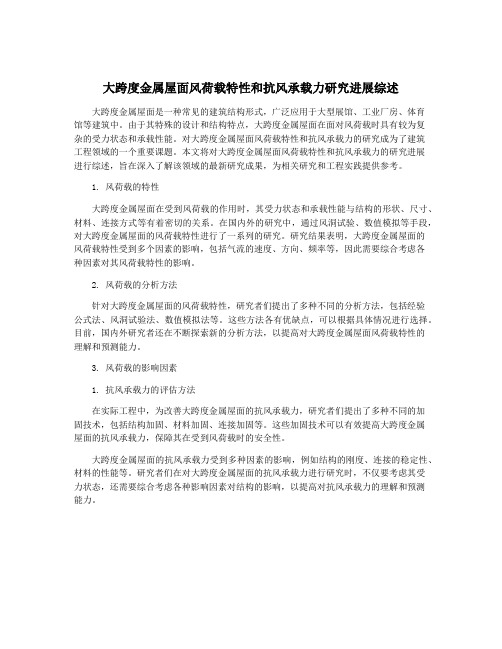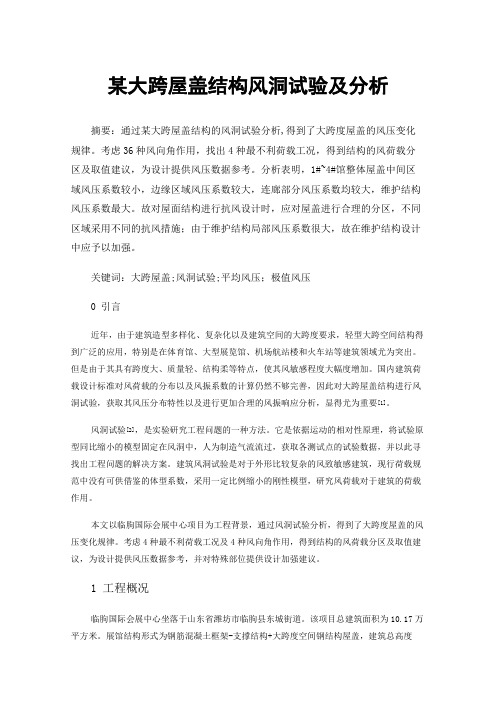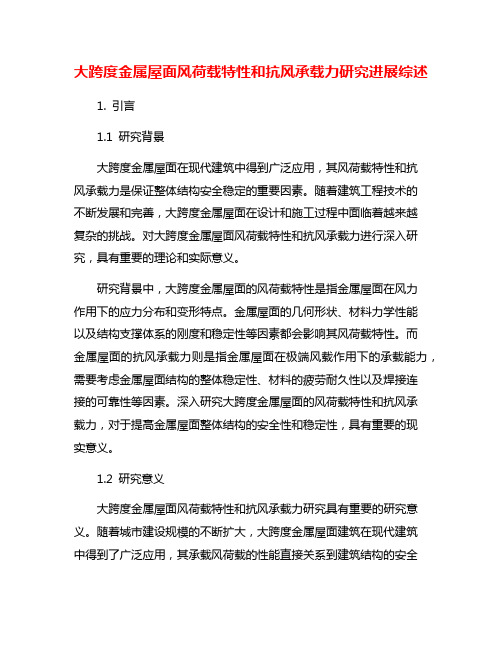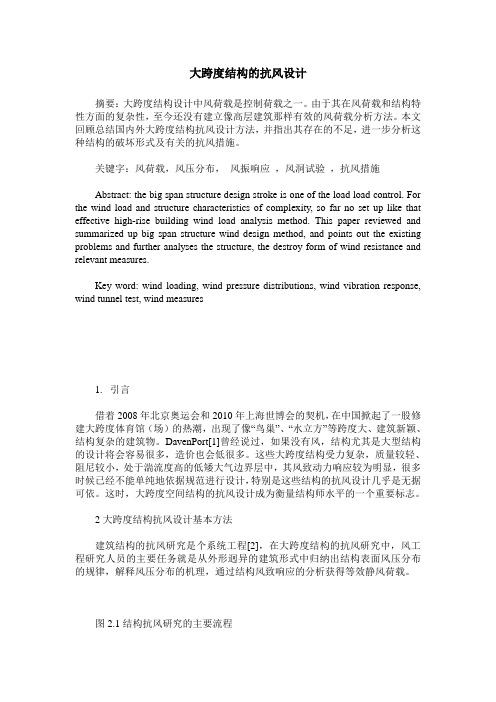大跨屋盖结构论文:大跨屋盖结构风荷载特性及抗风设计研究
大跨度屋盖结构风洞试验研究报告

大跨度屋盖结构风洞试验研究报告摘要:本研究利用风洞试验的方法,对大跨度屋盖结构的风荷载特性进行了详细研究。
通过在风洞中模拟真实气象条件下的风场,对不同大跨度屋盖结构进行试验,并测量了其受风荷载时的位移、应力等参数。
试验结果表明,大跨度屋盖结构的风荷载特性与气象条件、结构形态等因素密切相关,为大跨度屋盖结构的设计与施工提供了重要的参考依据。
引言:大跨度屋盖结构因其合理的设计、良好的景观性和广泛的应用领域而备受关注。
然而,由于其结构特点导致的风荷载问题一直是该领域的热点和难点。
风洞试验是研究大跨度屋盖结构风荷载特性的重要方法之一,其模拟真实风场,能够测量结构在风荷载作用下的位移、应变、应力等参数,为结构安全性与可靠性的评估提供准确的数据。
试验方法:本研究选择了一种常见的大跨度屋盖结构作为试验对象,通过风洞模拟真实气象条件下的风场,并使用专业的传感器测量受风荷载作用下的位移、应变、应力等参数。
试验过程中,分别模拟了不同风速、风向等条件,以全面了解结构在不同风荷载下的工作性能。
试验结果与分析:试验结果表明,大跨度屋盖结构在不同风荷载下表现出不同的受力特性。
当风速较小时,结构的受力处于较小的范围内,位移、应变、应力等参数较小。
随着风速的增加,结构逐渐受到较大的风荷载,位移、应变、应力等参数增大。
同时,试验还发现,结构的形态对其受力特性影响较大。
例如,当结构采用弧形或三角形的设计时,其承受风荷载的能力更强,位移、应变、应力等参数较小。
结论:通过大跨度屋盖结构风洞试验,本研究深入研究了结构在风荷载作用下的特性。
试验结果表明,大跨度屋盖结构的受力性能与气象条件、结构形态等因素有着密切的关系。
因此,在大跨度屋盖结构的设计与施工中,应综合考虑这些因素,以确保结构的安全性与可靠性。
分析复杂大跨度屋盖结构的风荷载特性及抗风设计

2018年第3期时代农机TIMES AGRICULTURAL MACHINERY第45卷第3期Vol.45No.32018年3月Mar.2018作者简介:陈晨(1992-),女,吉林松原人,硕士研究生,主要研究方向:结构风工程。
分析复杂大跨度屋盖结构的风荷载特性及抗风设计陈晨(,130600)摘要:针对目前复杂大跨度屋盖结构的抗风设计存在的局限问题,文章从实践角度出发,分析了大跨度屋盖结构所处的复杂环境与抗风设计问题,并在明确风荷载特性的情况下对抗风设计进行了优化控制,为相关建设者提供一些理论依据。
关键词:复杂大跨度;屋盖结构;风荷载特性;抗风设计经济水平的不断提升,使人们对大跨度屋盖结构工程的建设效果不仅仅停留在安全可靠,还要具备一定的美观效果。
而抗风设计的复杂性,降低了建筑目标的实现效率。
为此,工程建设者应从实践角度出发,即在明确抗风设计局限的基础上对风荷载特性进行分析,以提高抗风设计策略的有效性。
1研究复杂大跨度屋盖结构风荷载特性及抗风设计的现实意义当前阶段,对于大跨度屋盖结构建造来说,会受到风荷载特性的影响,而降低抗风设计的科学有效性。
再加上,经济水平的不断提升,使人们对建筑物建设使用的美观性需求越来越高。
此工程建设背景下,就在很大程度上增加了复杂大跨度屋盖结构设计工作量,即需综合考虑多方面因素来强化屋盖结构设计合理性。
为提高复杂大跨度屋盖结构设计的有效性,相关人员应对当前已建工程的屋盖结构抗风设计情况进行分析,即在明确抗风设计局限问题的基础上,结合风荷载特性的影响从而控制实践高效的抗风设计策略。
2复杂大跨度屋盖结构的抗风设计局限研究表明,复杂大跨度屋盖结构的抗风设计在风荷载的作用下,需要对基本风压值进行计算,进而确定建筑物建设使用的抗风设防标准。
现阶段,复杂大跨度屋盖结构的抗震设计已经有相关的规范标准进行质量效果控制,但抗风设计的分析还处在单一的抗风设防标准上。
而且,屋盖结构的抗风设计还会受到不断变化的结构参数影响,而降低抗风设计的效果。
大跨度金属屋面风荷载特性和抗风承载力研究进展综述

大跨度金属屋面风荷载特性和抗风承载力研究进展综述大跨度金属屋面是一种常见的建筑结构形式,广泛应用于大型展馆、工业厂房、体育馆等建筑中。
由于其特殊的设计和结构特点,大跨度金属屋面在面对风荷载时具有较为复杂的受力状态和承载性能。
对大跨度金属屋面风荷载特性和抗风承载力的研究成为了建筑工程领域的一个重要课题。
本文将对大跨度金属屋面风荷载特性和抗风承载力的研究进展进行综述,旨在深入了解该领域的最新研究成果,为相关研究和工程实践提供参考。
1. 风荷载的特性大跨度金属屋面在受到风荷载的作用时,其受力状态和承载性能与结构的形状、尺寸、材料、连接方式等有着密切的关系。
在国内外的研究中,通过风洞试验、数值模拟等手段,对大跨度金属屋面的风荷载特性进行了一系列的研究。
研究结果表明,大跨度金属屋面的风荷载特性受到多个因素的影响,包括气流的速度、方向、频率等,因此需要综合考虑各种因素对其风荷载特性的影响。
2. 风荷载的分析方法针对大跨度金属屋面的风荷载特性,研究者们提出了多种不同的分析方法,包括经验公式法、风洞试验法、数值模拟法等。
这些方法各有优缺点,可以根据具体情况进行选择。
目前,国内外研究者还在不断探索新的分析方法,以提高对大跨度金属屋面风荷载特性的理解和预测能力。
3. 风荷载的影响因素1. 抗风承载力的评估方法在实际工程中,为改善大跨度金属屋面的抗风承载力,研究者们提出了多种不同的加固技术,包括结构加固、材料加固、连接加固等。
这些加固技术可以有效提高大跨度金属屋面的抗风承载力,保障其在受到风荷载时的安全性。
大跨度金属屋面的抗风承载力受到多种因素的影响,例如结构的刚度、连接的稳定性、材料的性能等。
研究者们在对大跨度金属屋面的抗风承载力进行研究时,不仅要考虑其受力状态,还需要综合考虑各种影响因素对结构的影响,以提高对抗风承载力的理解和预测能力。
某大跨屋盖结构风洞试验及分析

某大跨屋盖结构风洞试验及分析摘要:通过某大跨屋盖结构的风洞试验分析,得到了大跨度屋盖的风压变化规律。
考虑36种风向角作用,找出4种最不利荷载工况,得到结构的风荷载分区及取值建议,为设计提供风压数据参考。
分析表明,1#~4#馆整体屋盖中间区域风压系数较小,边缘区域风压系数较大,连廊部分风压系数均较大,维护结构风压系数最大。
故对屋面结构进行抗风设计时,应对屋盖进行合理的分区,不同区域采用不同的抗风措施;由于维护结构局部风压系数很大,故在维护结构设计中应予以加强。
关键词:大跨屋盖;风洞试验;平均风压;极值风压0 引言近年,由于建筑造型多样化、复杂化以及建筑空间的大跨度要求,轻型大跨空间结构得到广泛的应用,特别是在体育馆、大型展览馆、机场航站楼和火车站等建筑领域尤为突出。
但是由于其具有跨度大、质量轻、结构柔等特点,使其风敏感程度大幅度增加。
国内建筑荷载设计标准对风荷载的分布以及风振系数的计算仍然不够完善,因此对大跨屋盖结构进行风洞试验,获取其风压分布特性以及进行更加合理的风振响应分析,显得尤为重要[1]。
风洞试验[2],是实验研究工程问题的一种方法。
它是依据运动的相对性原理,将试验原型同比缩小的模型固定在风洞中,人为制造气流流过,获取各测试点的试验数据,并以此寻找出工程问题的解决方案。
建筑风洞试验是对于外形比较复杂的风致敏感建筑,现行荷载规范中没有可供借鉴的体型系数,采用一定比例缩小的刚性模型,研究风荷载对于建筑的荷载作用。
本文以临朐国际会展中心项目为工程背景,通过风洞试验分析,得到了大跨度屋盖的风压变化规律。
考虑4种最不利荷载工况及4种风向角作用,得到结构的风荷载分区及取值建议,为设计提供风压数据参考,并对特殊部位提供设计加强建议。
1 工程概况临朐国际会展中心坐落于山东省潍坊市临朐县东城街道。
该项目总建筑面积为10.17万平方米。
展馆结构形式为钢筋混凝土框架-支撑结构+大跨度空间钢结构屋盖,建筑总高度32.2m,展厅屋盖横向跨度72.0m,呈南高北低的弧形造型,横向主受力构件采用了倒三角形空间管桁架。
大跨房屋钢结构论文

大跨钢结构及其应用摘要随着中国经济的持续高速发展,遍布全国的经济技术开发区正以前所未有的建设规模兴建各类钢结构建筑,我国网架、网壳结构等大跨空间钢结构获得广泛应用的实际情况,将其归结为结构形式多样化、结构新材料应用的拓展及现代预应力技术的引用。
其中不少单体的建筑面积往往达数万乃至数十万平方米。
同时为适应各种自动化生产线的工艺要求,厂房的跨度及柱网也越来越大。
钢结构建筑是继钢筋混凝土建筑之后的最具革命性建筑的新发展和新应用。
轻钢结构建筑的特点突出:整体刚度和抗震性能好、施工速度快、结构占有面积小、承载力高,在工业厂房中钢结构逐渐代替了钢筋混凝土结构,以其大跨度、大空间的表现在建筑规模上相当出色。
关键词:大跨空间钢结构;网架结构;应用与发展;特点1 大跨空间钢结构简介1.1 大跨空间钢结构随着我国经济建设的蓬勃发展,网架、候机厅、会展中心、会堂、剧院等大型公共建筑及不同类型的工业建筑获得了广泛应用。
习惯上,通常将空间结构按形式分为五大类,即薄壳结构(包括折板结构)、网架结构、网壳结构、悬索结构和膜结构,称为五大空间结构。
其中,膜结构可分为充气膜结构和支承膜结构,前者又可分为气囊式膜结构(囊中气压为3~7个大气压,称高压体系)和气承式膜结构(膜内气压1.003个大气压左右,称低压体系),后者又可分为刚性支承膜结构(支承在刚度较大的如拱、梁、桁架、网架等支承结构上,又称骨架式膜结构)和柔性支撑膜结构(支承在脊索、谷索、边索、桅杆等柔度较大的支承结构上,又称张拉式膜结构)。
在五太空间结构的基础上,平板型的网架结构和曲面型的网壳结构可合并总称为网格结构(新的《土木工程名词》已经正式推荐采用“空间构架”这一名词,相当于英文的Space Frame,这里仍根据习惯称为网格结构);而悬索结构与膜结构也可合并总称为张拉结构。
1.2 大跨空间钢结构特点1.2.1 结构形式多样化,大跨空间钢结构多姿多彩在这实际的三维世界里,任何结构物本质上都是空间性质的,只不过出于简化设计和建造的目的,人们在许多场合把它们分解成一片片平面结构来进行构造和计算。
大跨屋盖围护结构风荷载极值及其不确定性

摘 要大跨屋盖结构跨度大、质量轻和柔度大,通常其结构表面绕流、结构-空气动力相互作用机理复杂,易在强风作用下发生破坏。
相对于主体结构而言,围护结构的风致破坏更为常见。
恰当而合理的围护结构设计风荷载是保证围护结构抗风性能的前提,其大小取决于结构表面具有一定保证率的极值风荷载。
风洞试验方法是获得围护结构极值风荷载的常用方法,从理论上说,无穷多次独立重复风洞采样可获得极值的真值。
而在围护结构风荷载的风洞试验中,通常采样的次数有限,采样的时长亦有限,因此围护结构设计风荷载基于极值概率统计模型采用概率统计方法获得。
合理的极值概率模型是预测围护结构极值风荷载的先决条件。
本文以大跨度平屋盖为研究对象,从屋盖表面风压的分布规律、表面风压极值的概率统计模型和不确定性入手,为大跨屋盖围护结构风压极值估计和不同极值估计方法的校准提供一个基于可靠度的评价机制。
本文主要进行了以下几个方面的工作:(1)大跨平屋盖表面风压特性研究。
本文对大跨平屋盖结构进行了缩尺比为1:200的刚性模型风洞测压试验,依据单次采样的结果,对结构表面的平均风压系数、脉动风压系数、极值风压系数以及块风压系数的分布规律进行了系统的研究,得出了大跨平屋盖结构表面风压分布的一些基本的分布规律。
(2)大跨平屋盖表面风压的概率统计模型及其不确定性研究。
本文依据大跨平屋盖结构的多次独立重复的缩尺刚性模型风洞测压试验结果,基于变异系数对可靠度的影响,确定了测点体型系数、极值风压系数,分块体型系数、极值风压系数的风洞试验采样次数标准;基于经典极值分布,对测点和分块极值风压系数进行了概率分布拟合,确定了对应的最佳拟合分布;基于拟合的极值分布,分析了不同的参数估计方法和极值分位数的选取对风压系数极值估计的影响。
(3)大跨平屋盖风压极值估计方法的比较及校准。
本文采用几种常用的极值估计方法:峰值因子法、阵风系数法、短时分段极值估计方法、多区组的经典极值估计方法、基于二阶矩可靠度理论的风压极值估计方法进行了大跨平屋盖风压极值的估计,比较了几种方法的极值估计结果差异,以基于二阶矩可靠度理论的风压极值估计方法的结果为基准,校准了几种常用方法,提出了相应的修正因子,推荐工程应用。
大跨钢屋盖抗风措施

大跨钢屋盖抗风措施
嘿,朋友们!今天咱来聊聊大跨钢屋盖抗风措施这个事儿。
你说这风啊,可真是个让人又爱又恨的家伙!有时候微风拂面挺舒服,但要是变成狂风,那可就不得了啦!
想象一下,那些高大的钢屋盖,就像是勇敢的卫士,要面对风这个强大的敌人。
那怎么才能让它们在风中稳稳当当呢?这可就得靠一系列厉害的抗风措施啦!
就好比我们人在大风天会找个避风的地方躲起来一样,大跨钢屋盖也有自己的“避风妙招”。
首先呢,得把它的结构设计得特别牢固,就像给它穿上了一层坚固的铠甲。
这可不是随随便便就能做到的,得经过精心的计算和设计呢!
然后啊,还有一些小细节也不能忽视。
比如增加一些特殊的连接部件,让各个部分紧密相连,共同抵抗风的冲击,这不就像是我们手挽手一起对抗困难嘛!还有啊,选用合适的材料也超级重要,就像我们挑衣服得挑质量好的一样。
要是没有这些抗风措施,那可不得了!钢屋盖可能会摇摇晃晃,甚至被风给吹坏了,那多危险啊!那造成的后果简直不敢想!
所以说啊,大跨钢屋盖抗风措施真的太重要啦!我们可不能小瞧了它们,这可是关系到我们安全和稳定的大事呢!。
大跨度金属屋面风荷载特性和抗风承载力研究进展综述

大跨度金属屋面风荷载特性和抗风承载力研究进展综述1. 引言1.1 研究背景大跨度金属屋面在现代建筑中得到广泛应用,其风荷载特性和抗风承载力是保证整体结构安全稳定的重要因素。
随着建筑工程技术的不断发展和完善,大跨度金属屋面在设计和施工过程中面临着越来越复杂的挑战。
对大跨度金属屋面风荷载特性和抗风承载力进行深入研究,具有重要的理论和实际意义。
研究背景中,大跨度金属屋面的风荷载特性是指金属屋面在风力作用下的应力分布和变形特点。
金属屋面的几何形状、材料力学性能以及结构支撑体系的刚度和稳定性等因素都会影响其风荷载特性。
而金属屋面的抗风承载力则是指金属屋面在极端风载作用下的承载能力,需要考虑金属屋面结构的整体稳定性、材料的疲劳耐久性以及焊接连接的可靠性等因素。
深入研究大跨度金属屋面的风荷载特性和抗风承载力,对于提高金属屋面整体结构的安全性和稳定性,具有重要的现实意义。
1.2 研究意义大跨度金属屋面风荷载特性和抗风承载力研究具有重要的研究意义。
随着城市建设规模的不断扩大,大跨度金属屋面建筑在现代建筑中得到了广泛应用,其承载风荷载的性能直接关系到建筑结构的安全性和稳定性。
研究大跨度金属屋面风荷载特性和抗风承载力,可以有效提高建筑结构的抗风性能,保障建筑物和人员的安全。
随着气候变暖和极端天气事件频繁发生,风荷载对建筑物的影响日益凸显。
通过深入研究大跨度金属屋面风荷载特性和抗风承载力,可以为制定更为科学合理的风荷载标准和设计规范提供有力的依据,从而提高建筑物的抗风能力,减少因风灾造成的损失。
对大跨度金属屋面风荷载特性和抗风承载力进行研究具有重要的理论与实践意义,可以为建筑结构设计、风灾防范和减灾减损提供科学依据,推动相关领域的发展和进步。
1.3 发展现状当前,随着现代建筑技术的不断发展和进步,大跨度金属屋面的应用范围越来越广泛。
大跨度金属屋面不仅具有较轻的自重和较高的强度,还具有较好的耐腐蚀性和抗风压性能。
由于金属材料的特殊性质,大跨度金属屋面在受到风荷载作用时容易产生振动和应力集中现象,导致屋面的承载能力受到挑战。
台风地区大跨度张弦结构屋面抗风设计与施工

台风地区大跨度张弦结构屋面抗风设计与施工论文
《台风地区大跨度张弦结构屋面抗风设计与施工论文》
我国大部分太平洋沿岸地区都属于台风路径,受到台风影响,其中以台风作用下大跨度张弦结构屋面的抗风性能为关注焦点。
本文旨在通过对抗风设计理论与可行性评估,实现台风地区大跨度张弦结构屋面的抗风设计与施工。
首先,在进行抗风设计之前,我们需要考虑抗风设计原则,例如减少重心的偏移、加强节点的抗拉性能及承载能力、设计适宜的构件几何形状。
其次,需要通过将可行性评估与抗风设计方案结合运用,考虑地理环境因素及台风历史作用情况,确定抗风设计方案,如屋面覆盖物及抗风构件的加固方法等。
最后,需要结合此抗风设计方案,根据台风地区的抗风施工规范来施工,以确保抗风性能的最佳效果。
综上所述,针对台风地区大跨度张弦结构屋面的抗风设计与施工,主要涉及抗风设计理论、可行性评估、抗风设计方案和台风地区抗风施工规范,确保屋面结构具备足够的抗风性能,以保障建筑物安全。
大跨屋盖结构论文:大跨屋盖结构风荷载特性及抗风设计研究

大跨屋盖结构论文:大跨屋盖结构风荷载特性及抗风设计研究【中文摘要】大跨屋盖结构一般是大型机场、车站或体育馆建筑的首选形式,而这类结构通常具有柔度大、阻尼小、质量轻等特点,风荷载成为作用在结构上的主要控制荷载,如何更精确的计算风荷载成为主导结构是否安全的最重要指标。
由于大跨屋盖的结构形式不完全相同,规范中并没有统一的计算方法来确定其风荷载数值,而提供的体形系数和风振系数还不能囊括所有的大跨形式,因此,有必要对不同的大跨结构做深入的抗风分析和研究。
木文结合青岛火车站站房屋盖的大跨结构形式,运用其刚性模型进行风洞试验,并建立有限元模型,从风压分布特性分析、风振系数的确定、静风荷载的加载等方面讨论结构对风荷载的响应,进而讨论结构的安全性。
本文第二章详细分析了屋盖上不同分区的测点平均风压系数和脉动风压系数的分布情况,并选取典型测点进行分析,进而总结风压分布规律,得出了有关大跨度屋盖结构表而风压分布的一些具有共性的规律,得岀各分区风压系数。
本文第三章讨论了风致响应的计算方法。
由风洞试验中得到的测点风压系数时程,经过一系列转换和修正,得到节点的脉动风荷载时程,通过对结构的前十阶振型的分析,讨论分区风振系数的取值,并最终得到屋盖整体的统一的风振系数。
第四章分析了屋盖结构的静风响应,选取作用在结构上的两种不同的荷载,由前两章的数据经过比较和筛选,最确定结构上每棍组合钢在自重作用下和在自重与静风组合荷载作用下的受力和变形,筛选最大应力和变形处与规范相关数值比较,最终确定结构的安全性。
最后,对进一步的结构设计和分析提出建议,本文所得结论对结构的设计和施工有参考意义,可作为相似结构设计的参考。
【英文摘耍】It is generally the first choice for large-scale airport, station and gymnasium to use long-span roof struetures with high flexibility, low damping and mass・ Wind loading is usually a dominated one acting on struetures, so it is the most important factor to judge the safety of structure under wind load accurately. However there is no general method of calculating wind load in the code because of configuration difference of long-span roof structures・ In the other hand the shape coefficient and the gust response coefficient suggested by the code can, t embrace all forms of long-span structures, so it is necessary to analyze and discuss the wind resistance character of different long-span structures in depth .Based on the stiff model of long-span structure in Qingdao railway station, wind tunnel test is carried out and finite element model is established, this paper discusses the structure? s response for the wind and the structure' s safety by analyzing the wind pressure distribution character, confirming the gust response coefficient, and exerting the static wind load. The second chapter of this paper discusses the distribution of mean wind pressure coefficients and fluctuating wind pressurecoefficients in different areas of the roof, typical points foranalyzing are selected, the regularity of wind pressuredistribution is summarized, and partition wind pressure coefficients are obtained. The third chapter discusses the computing method of wind responsive. After a series of conversion and amendment, the nodes' fluctuating wind load history-time can be gotten from the measured wind pressure coefficient history-time, and the partition values of gust response coefficient are discussed by analyzing the first ten vibration modes, finally, the unified gust response coefficient of the whole roof is got, which is prepared for the next step of loading the static wind load. The forth chapter einalyzes the responsc for static wind load on the roof, two different loads loading on the structure are selected, and the former two chapters' data are chosen and screened, then the carrying capability and deformation for the combined steel column of each rank under the dead load only and combination of the dead load and the wind load are confirmed, the maximum stress and deformation are chosen to compare with the code, finally thestructures safety is assessed. Finally, thefurther structure design and analysis are suggested, the conclusions of this paper can be referred to the structure f s design and construetion, particularly for similar long-span roof structures・【关键词】大跨屋盖结构风洞试验平均风压系数风振系数风荷载特性【英文关键词】long-span roof structure wind tunnel test mean wind pressure coefficient gust response coefficient wind load character【目录】大跨屋盖结构风荷载特性及抗风设计研究摘要6-7Abstract7第1章绪论11-211. 1选题背景11T31. 2基本理论13-201.2. 1近地风特性13-171. 2. 2风荷载研究手段17-201. 2. 2. 1 现场实测17-181. 2. 2. 2风洞试验18-191. 2. 2. 3数值模拟19-201. 3 本文进行的工作20-21第2章大跨度屋盖结构风压分布特性分析21-352. 1引言21-222. 2刚性模型风洞试验方法22-242. 3试验数据处理24-252. 4试验结果分析25-332. 4. 1屋面轮廓形状对风压分布的影响25-272.4. 2典型测点的平均风压系数随风向角的变化27-292. 4. 3典型测点的脉动风压系数随风向角变化规律29-302. 4. 4 风压系数的空间分布特点30-332. 5本章小结33-35第3章大跨度屋盖结构的风致振动特性研究35-523. 1引言35-373. 2结构风振响应的一般计算方法37-423. 3结构风振响应的时程分析法42-433. 4 青岛火车站站房屋盖的风振响应分析43-513. 4. 1结构有限元模型及动力特性43-493. 4. 2风振系数计算分析49-513. 5本章小结51-52 第4章大跨度屋盖结构的风荷载分布分析52-614. 1引言524. 2结构体系与分析模型52-554. 2. 1结构体系52-534. 2. 2结构分析模型53-544. 2. 3节点静力风荷载的计算54-554. 3最不利风向角的确定55-574. 4大跨屋盖结构的静风效应57-604. 5本章小结60-61第5 章结论与展望61-635. 1本文工作总结615.2进一步工作展望61-63致谢63-64参考文献64-66。
大跨结构抗风研究现状及展望_康继武

42
空 间 结 构
第 15 卷
100 多万平方英里的地方夷为平地 , 损失达到 300
亿美元 ,7 家保险公司因无法承受赔债而倒闭 . 实际 上 , 除美国外 , 其他国家的风灾损失也十分惊人 . 1991 年孟加拉国风灾造成 14 万人丧生 , 损坏或摧 毁 100 万间民房 , 造成 30 亿美元损失 , 相当于孟加 拉国国民总产值的 10 % ; 而 1994 年孟加拉国二次 风灾又造成 44 万人死亡 ,损失更加惊人 . 在我国风灾损失也是十分惊人的 , 而且随着经 济建设的发展 ,近年有逐年增大的趋势 . 20 世纪 80 年代中国年平均损失 30 ~ 40 亿元 , 而 90 年代前 5 年已年损 100 亿元以上 , 单单 1994 年 9415 号这一 次台风袭击浙江 , 就造成倒塌和损坏房屋 80 多万 间 ,倒掉通信电杆 2397km , 死亡 1000 多人 , 机场屋 盖也被吹坏 ,99m 高的通讯铁塔也被狂风刮倒 . 直 接经济损失达 108 亿人民币 ,加上间接损失 ,总数达
) ,男 ,陕西佳县人 ,硕士研究生 ,从事工程力学方面研究 . 作者简介 : 唐继武 (1984 —
通讯联系人 : 聂国隽 ,女 ,副教授 . E2mail :ngj @mail . tongji. edu. cn
© 1994-2010 China Academic Journal Electronic Publishing House. All rights reserved.
第1期
康继武 ,等两个明显趋势 : 一是风洞尺寸 的大型化 ,二是风洞功能的多样化 . 此外还有一种做 法 ,是在试验段下部设置波浪模拟水槽 ,使之成为建 筑工程和海洋工程的两用风洞 [ 2 ,4 ] . 数值风洞技术 ( CFD ) 适用范围较广 , 能够形象 细致地再现许多流动现象 . 它的测量系统对流动不 会产生任何扰动 ,且所需时间和费用也要比风洞试 验少得多 . 它可以构造与实际结构尺寸相同的计算 模型 ,从而避免了在风洞试验中由于采用缩尺模型 所带来的相似比问题 . 它可以完全控制流体的性质 , 且对于流动参数的选择具有较大的灵活性 , 因而便 于进行各种参数的分析 . 这些优点使得数值风洞技 术一直受到国内外学者的普遍关注 , 并且在航空领 域得到了较为成功的应用 . 但是在土木工程领域 ,由 于以往对湍流的数值模拟技术还不成熟 , 使得数值 风洞技术的应用受到一定限制 . 近年来 ,随着相关研 究领域的飞速发展 ,一些限制瓶颈逐渐被打破 ,应用 数值风洞技术来模拟结构绕流问题已成为可能 [ 3 ] , 如文献 [ 5 ] 利用 CFX51 5 模拟了体育场弧形挑篷的 平均风荷载 .
大跨屋盖结构风荷载特性研究共3篇

大跨屋盖结构风荷载特性研究共3篇大跨屋盖结构风荷载特性研究1大跨屋盖结构风荷载特性研究随着现代建筑技术的不断发展,越来越多的大跨屋盖结构被应用于大型体育馆、会展中心等场馆中。
这些结构具有体积大、构造复杂、自重大的特点,同时还需考虑极端气象条件下的风荷载对其安全性的影响。
因此,对于大跨屋盖结构风荷载特性的研究具有重要的意义。
风是大跨屋盖结构最常见的外部荷载之一,因此研究大跨屋盖结构的风荷载特性是极其必要的。
在研究大跨屋盖结构的风荷载特性时,要考虑以下三个方面。
首先,气象条件是影响风荷载特性的关键因素之一。
气象条件包括气温、湿度、大气压力、风向、风速等因素。
不同的气象条件会对大跨屋盖结构的风荷载产生不同的影响。
例如,在高温、低湿度的气象条件下,大气密度较小,风荷载的大小也会明显减小。
而在低温、高湿度的气象条件下,大气密度较大,风荷载的大小则会明显增加。
其次,大跨屋盖结构的形状大小和材料是影响风荷载特性的重要因素之二。
结构的形状和大小决定了大跨屋盖结构的面积和体积,从而影响了结构的自重和风荷载的大小。
例如,在相同的风速下,一个球形的屋盖结构所受到的风荷载显然要小于一个平面的屋盖结构。
而材料的选择直接影响了结构的刚度、强度和稳定性,从而影响了风荷载的分布和大小。
最后,大跨屋盖结构的支座方式是影响风荷载特性的第三个因素。
不同的支座方式会影响结构的倾斜度和位移,从而影响结构的稳定性和安全性。
为了保证结构的稳定性和安全,支座的刚度和强度必须要足够大。
总之,大跨屋盖结构风荷载特性的研究是一项复杂而又必要的工作。
需要综合考虑气象条件、结构的形状、大小和材料,以及支座方式对其所受风荷载的影响。
只有通过全面深入的研究,才能更好地保证大跨屋盖结构的安全稳定性综上所述,大跨屋盖结构的风荷载特性与多个因素相关,包括气象条件、结构的形状、大小和材料,以及支座方式等。
在设计和建造大跨屋盖结构时,必须综合考虑这些因素,以确保其稳定性和安全性。
大跨度结构的抗风设计

大跨度结构的抗风设计摘要:大跨度结构设计中风荷载是控制荷载之一。
由于其在风荷载和结构特性方面的复杂性,至今还没有建立像高层建筑那样有效的风荷载分析方法。
本文回顾总结国内外大跨度结构抗风设计方法,并指出其存在的不足,进一步分析这种结构的破坏形式及有关的抗风措施。
关键字:风荷载,风压分布,风振响应,风洞试验,抗风措施Abstract: the big span structure design stroke is one of the load load control. For the wind load and structure characteristics of complexity, so far no set up like that effective high-rise building wind load analysis method. This paper reviewed and summarized up big span structure wind design method, and points out the existing problems and further analyses the structure, the destroy form of wind resistance and relevant measures.Key word: wind loading, wind pressure distributions, wind vibration response, wind tunnel test, wind measures1. 引言借着2008年北京奥运会和2010年上海世博会的契机,在中国掀起了一股修建大跨度体育馆(场)的热潮,出现了像“鸟巢”、“水立方”等跨度大、建筑新颖、结构复杂的建筑物。
DavenPort[1]曾经说过,如果没有风,结构尤其是大型结构的设计将会容易很多,造价也会低很多。
大跨屋盖结构抗风设计

(3)时程分析法。即直接运用风洞试验测得的风压 时程作用于屋盖结构而进行风振响应时程分析。首先建 立屋盖结构的有限元模型,然后通过动力计算得到结构 的动力响应,统计结构动力响应从而算得结构的风振系 数。这种方法思路简单,计算复杂而且耗时较多,但精 度高,可靠性好,适用性强,可以计算结构非线性。 (4)模态力法。这种方法的优点是计算简便,缺点 是不能考虑结构的非线性。
三. 有限元法
7.3 屋盖结构的风振响应
目前,屋盖结构的风荷载研究主要采用风洞 实验、灾后调查、全尺寸实测以及计算机仿真数 值模拟分析等手段。研究内容主要包括屋盖结构 形式的改进、风荷载的影响因素以及计算理论和 屋盖抗风减振措施等。
对于高层结构风载设计中的风振系数,我国规范采用简便 的近似计算方法,而在大跨度屋盖中由于结构形式的多样性 和分析的复杂性,我国规范在这一方面还是空白,也是当前 风工程的研究热点之一。通常对于大跨度屋盖结构风振响应 分析和风振系数的求解方法有四种。 (1)频域法。由通用的风速谱,通常是Davenport谱基于 准定常假设而推得风压谱、力谱,然后通过动力传递系数得 到结构的动力反应谱,由随即理论可以通过反应谱的积分得 到结构的动力响应。这种方法计算简单、方便。 (2)修正频域法。由于准定常假设在大跨度屋盖结构中不 成立,因此可以采用风洞试验中测得的风压时程通过傅立叶 变换直接转化为风压谱,进而运用谱分析法计算屋盖响应分 析。这种方法计算简单、方便,但是它对测点的布置有一定 的要求且不能计算结构的非线性。
η xபைடு நூலகம்z1 ≈ η xη yη z1
式中 η z1 ——高度方向风压空间相关性折算系数,由于 屋盖部分高度变化很小,取 η z1 = 1 ; η η x 、 y ——水平 x 方向和 y 方向风压空间相关性折 算系数。
大跨度屋盖结构的抗风设计缺陷与对策

陈艳 C HE N Ya n ; 梁鹏 L I ANG P e n g
( 三 亚市 城 市 规 划 设 计研 究 院 , -, - I V 5 7 2 0 0 0)
( S a n y a U r b a n P l a n n i n g a n d D e s i g n ̄s i f me , S a n y a 5 7 2 0 0 0, C h i n a )
破 坏 总从 拐 角 、 屋顶脊梁 、 屋 盖边缘悬 空处发 生 , 或 钢筋混凝土 , 其基本原材 料是水 泥和钢材。 接着 , 大胆 的设 压 力 , 者 由 于 邻 家 屋 顶 发 生 破 坏 , 使 屋 盖 也 被 触 动 , 进 而 发 生 破 计和理念广泛为设计师们运用 , 以钢 架 托 起 的 大 跨 度 屋 盖 据 此而 知 , 屋 盖 覆 盖 物 跟 支 架 的连 接 力 必须 加 强 , 屋 盖 此起彼伏 , 或 者 铝 合 金材 料 的 的 网格 架 也 被 应 用 在 大 跨度 坏 。 屋 面拐 角 、 边缘 悬空部分、 屋 的屋 盖 设计 上 , 有 的 场 地 在 下 雨 天 还 能 关上 屋 顶 , 在 晴 天 支 架跟 房 体 的衔 接 必须 稳 固 , 可 以 打 开 硕 大 的屋 顶 让 人 们 沐 浴 阳 光 。 这些 例 子 都 强 有 力 脊 处 的连 接 力 必须 提 升 。 2 . 2 大 跨屋 盖在 建造 过 程 中 存 在 的 问题 在 大 跨 度 屋 地 证 明 了大 跨 度 屋 盖 完 成 突破 的 两 个 条件 , 即理 念 和 技 术 盖建造过程 中, 不仅面对技 术和材 料上 的难 题 , 还 有主观 上进步。 近年来 , 随着科 技 日益进 步 , 一些条件 非常优越 的
・l 1 4・
大跨度空间结构开孔屋盖的风荷载特性研究

D H 3 8 1 9的无线静态应变采集器 , 通过 D H 3 8 1 9无线静态应变采
并进行 实验 设备的调试, 为风 洞试验做好 由于大跨屋盖形式各异 , 目前还 没有统一 的模型来描述屋盖 集器与工程 电脑连接,
上 的风荷载 , 我国现 行规范也没有作 明确规定 , 所 以刚性模型 的 充足 的准 备 。
1 9
9 2 ≥ 1 6
≥ 6 l ≥ 7 8 l 1 0 5 9 l 0
图 1 屋盖结构模型
. 3 试 验过程 育场屋盖 的风致响应 ,并对位移功率谱密 度函数进行 了对 比分 2 本试验采用控制单一变量法 ,分别针对屋盖在不 同角度 、 不 析。
然而 , 现 阶段 国 内外 学 者对 于顶 部 开 孔 的 屋 盖 结构 几 乎 没 有 同风速和不 同开孔下屋盖 的风荷载效应进行研 究,实验 具体分 。 研究 , 尤其是关于屋盖在开孔条件下的风荷载 响应研究更少。故 组 设 置 如 表 2
2 . 1 试 验材料
为 了满 足 为 了充 分 满足 理想 条 件 下 的 刚 性要 求 , 实 验材 料 采
4
5
2 1
2 1
7 5
4 5
测试在风速 为 O m /
s 、 2 m / s 、 4 m/ s 、 6 m / s 、
用 由甲基 烯酸 甲酯单 体 ( MMA ) 聚合而成亚 克力板材有机 玻璃 。 材料参数如表 1 所示 。
6
7
2 1
42
3 0
75
8 m/ s 、 1 0 m/ s的 作 用 下 各测 点应 变 值
8 9
4 2 4 2
4 5 3 0
大跨空间顶篷结构设计

大跨空间顶篷结构设计摘要:某运动会开幕式主会场看台下部为混凝土和钢混合结构。
顶棚结构出挑跨度达68米,采用斜拉主桁架及折板网格组成的混合体系。
通过预应力找力、找形得到斜拉结构初始态,在此基础上对上部钢结构进行了全面的计算分析,并考察了上部结构的抗连续倒塌性能。
通过分析保证了结构的安全性和经济性。
总结了一些斜拉大跨屋盖的设计经验,可供同类工程参考。
关键词:斜拉空间网格结构;预应力找形;预应力找力;连续倒塌分析Abstract: some main venue for the opening ceremony of the lower stands concrete and steel composite structures. Ceiling structure piece carry the span of the 68 meters, the main truss cables and fold board of mixed system of the grid. Through the prestressed find force, find form get initial state cables structure, on the basis of the steel structure, the overall calculation and analysis, and the effects of the resistance of the upper structure of the continuous collapsed performance. Through the analysis of the structure of the guarantee safety and efficiency. Summarizes some big span roof cables design experience for other similar projects.Keywords: batter space grid structure; Prestressed find form; Prestressed find power; Continuous collapsed analysis工程背景运动会主会场看台建筑通常在顶部设置钢结构顶篷,本工程为广州某体育场馆看台,为一栋八层建筑,平面呈扇形。
- 1、下载文档前请自行甄别文档内容的完整性,平台不提供额外的编辑、内容补充、找答案等附加服务。
- 2、"仅部分预览"的文档,不可在线预览部分如存在完整性等问题,可反馈申请退款(可完整预览的文档不适用该条件!)。
- 3、如文档侵犯您的权益,请联系客服反馈,我们会尽快为您处理(人工客服工作时间:9:00-18:30)。
大跨屋盖结构论文:大跨屋盖结构风荷载特性及抗风设计研究
大跨屋盖结构论文:大跨屋盖结构风荷载特性及抗风设计研究
【中文摘要】大跨屋盖结构一般是大型机场、车站或体育馆建筑的首选形式,而这类结构通常具有柔度大、阻尼小、质量轻等特点,风荷载成为作用在结构上的主要控制荷载,如何更精确的计算风荷载成为主导结构是否安全的最重要指标。
由于大跨屋盖的结构形式不完全相同,规范中并没有统一的计算方法来确定其风荷载数值,而提供的体形系数和风振系数还不能囊括所有的大跨形式,因此,有必要对不同的大跨结构做深入的抗风分析和研究。
本文结合青岛火车站站房屋盖的大跨结构形式,运用其刚性模型进行风洞试验,并建立有限元模型,从风压分布特性分析、风振系数的确定、静风荷载的加载等方面讨论结构对风荷载的响应,进而讨论结构的安全性。
本文第二章详细分析了屋盖上不同分区的测点平均风压系数和脉动风压系数的分布情况,并选取典型测点进行分析,进而总结风压分布规律,得出了有关大跨度屋盖结构表面风压分布的一些具有共性的规律,得出各分区风压系数。
本文第三章讨论了风致响应的计算方法。
由风洞试验中得到的测点风压系数时程,经过一系列转换和修正,得到节点的脉动风荷载时程,通过对结构的前十阶振型的分析,讨论分区风振系数的取值,并最终得到屋盖整体的统一的风振系数。
第四章分析了屋盖结构的静风响应,选取作用在结构上的两种不同的荷载,由前两章的数据经过比较和筛选,最确定结构上每榀组合钢在自重作用下和在自重与
静风组合荷载作用下的受力和变形,筛选最大应力和变形处与规范相关数值比较,最终确定结构的安全性。
最后,对进一步的结构设计和分析提出建议,本文所得结论对结构的设计和施工有参考意义,可作为相似结构设计的参考。
【英文摘要】It is generally the first choice for
large-scale airport, station and gymnasium to use long-span roof structures with high flexibility, low damping and mass. Wind loading is usually a dominated one acting on structures, so it is the most important factor to judge the safety of structure under wind load accurately. However there is no general method of calculating wind load in the code because of configuration difference of long-span roof structures. In the other hand the shape coefficient and the gust response coefficient suggested by the code can’t embrace all forms of long-span structures, so it is necessary to analyze and discuss the wind resistance character of different long-span structures in depth.Based on the stiff model of long-span structure in Qingdao railway station, wind tunnel test is carried out and finite element model is established, this paper discusses the structure’s response for the wind and the structure’s safety by analyzing the wind pressure distribution character, confirming the gust response coefficient, and
exerting the static wind load.The second chapter of this paper discusses the distribution of mean wind pressure coefficients and fluctuating wind pressure coefficients in different areas of the roof, typical points for analyzing are selected, the regularity of wind pressure distribution is summarized, and partition wind pressure coefficients are obtained.The third chapter discusses the computing method of wind responsive. After a series of conversion and amendment, the nodes’fluctuating wind load history-time can be gotten from the measured wind pressure coefficient history-time, and the partition values of gust response coefficient are discussed by analyzing the first ten vibration modes, finally, the unified gust response coefficient of the whole roof is got, which is prepared for the next step of loading the static wind load.The forth chapter analyzes the response for static wind load on the roof, two different loads loading on the structure are selected, and the former two chapters’data are chosen and screened, then the carrying capability and deformation for the combined steel column of each rank under the dead load only and combination of the dead load and the wind load are confirmed, the maximum stress and deformation are chosen to compare with the code, finally the structure’s safety is assessed.Finally,
the further structure design and analysis are suggested, the conclusions of this paper can be referred to the structure’s design and construction, particularly for similar long-span roof structures.
【关键词】大跨屋盖结构风洞试验平均风压系数风振系数风荷载特性
【英文关键词】long-span roof structure wind tunnel test mean wind pressure coefficient gust response coefficient wind load character
【目录】大跨屋盖结构风荷载特性及抗风设计研究摘要
6-7Abstract7第1章绪论11-211.1 选题背景11-131.2 基本理论13-201.2.1 近地风特性13-171.2.2 风荷载研究手段17-201.2.2.1 现场实测17-181.2.2.2 风洞试验18-191.2.2.3 数值模拟19-201.3 本文进行的工作20-21第2章大跨度屋盖结构风压分布特性分析
21-352.1 引言21-222.2 刚性模型风洞试验方法22-242.3 试验数据处理24-252.4 试验结果分析25-332.4.1 屋面轮廓形状对风压分布的影响25-272.4.2 典型测点的平均风压系数随风向角的变化
27-292.4.3 典型测点的脉动风压系数随风向角变化规律
29-302.4.4 风压系数的空间分布特点30-332.5 本章小结33-35第3章大跨度屋盖结构的风致振动特性研究35-523.1 引言35-373.2 结构风振响应的一般计算方法37-423.3 结构风振响应的时程分析
法42-433.4 青岛火车站站房屋盖的风振响应分析43-513.4.1 结构
有限元模型及动力特性43-493.4.2 风振系数计算分析49-513.5 本章小结51-52第4章大跨度屋盖结构的风荷载分布分析52-614.1 引言524.2 结构体系与分析模型52-554.2.1 结构体系52-534.2.2 结构分析模型53-544.2.3 节点静力风荷载的计算54-554.3 最不利风向角的确定55-574.4 大跨屋盖结构的静风效应57-604.5 本章小结60-61第5章结论与展望61-635.1 本文工作总结615.2 进一步工作展望61-63致谢63-64参考文献64-66。
